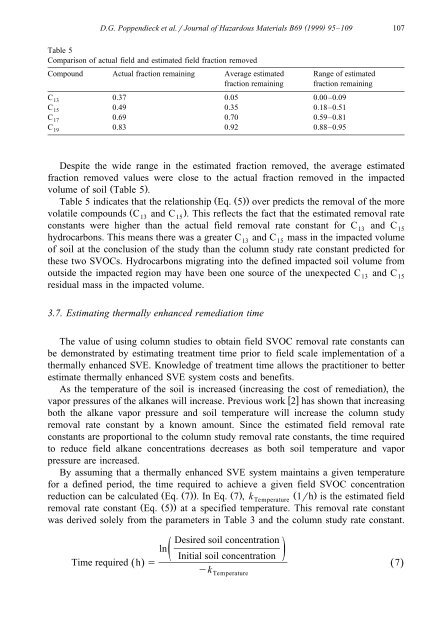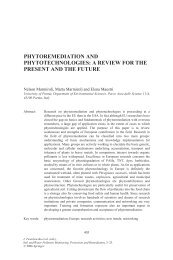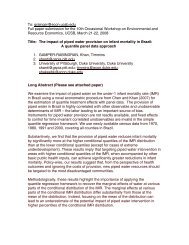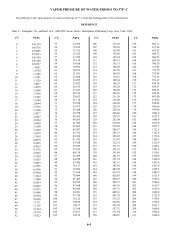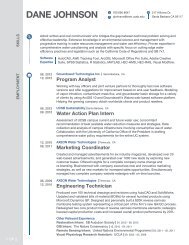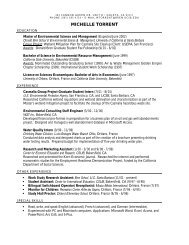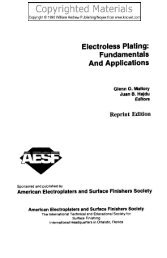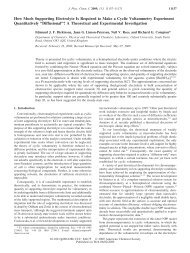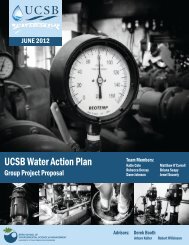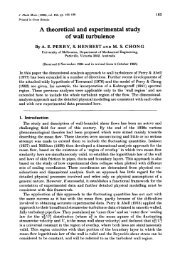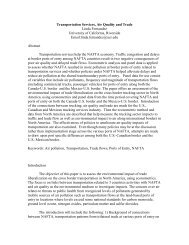SVE Thermal Enhancement
SVE Thermal Enhancement
SVE Thermal Enhancement
- No tags were found...
You also want an ePaper? Increase the reach of your titles
YUMPU automatically turns print PDFs into web optimized ePapers that Google loves.
( )D.G. Poppendieck et al.rJournal of Hazardous Materials B69 1999 95–109 107Table 5Comparison of actual field and estimated field fraction removedCompound Actual fraction remaining Average estimated Range of estimatedfraction remaining fraction remainingC 0.37 0.05 0.00–0.0913C 0.49 0.35 0.18–0.5115C170.69 0.70 0.59–0.81C190.83 0.92 0.88–0.95Despite the wide range in the estimated fraction removed, the average estimatedfraction removed values were close to the actual fraction removed in the impactedvolume of soil Ž Table 5 ..Table 5 indicates that the relationship ŽEq. Ž 5..over predicts the removal of the morevolatile compounds Ž C and C .13 15 . This reflects the fact that the estimated removal rateconstants were higher than the actual field removal rate constant for C13 and C15hydrocarbons. This means there was a greater C13 and C15mass in the impacted volumeof soil at the conclusion of the study than the column study rate constant predicted forthese two SVOCs. Hydrocarbons migrating into the defined impacted soil volume fromoutside the impacted region may have been one source of the unexpected C13 and C15residual mass in the impacted volume.3.7. Estimating thermally enhanced remediation timeThe value of using column studies to obtain field SVOC removal rate constants canbe demonstrated by estimating treatment time prior to field scale implementation of athermally enhanced <strong>SVE</strong>. Knowledge of treatment time allows the practitioner to betterestimate thermally enhanced <strong>SVE</strong> system costs and benefits.As the temperature of the soil is increased Ž increasing the cost of remediation ., thevapor pressures of the alkanes will increase. Previous work wx 2 has shown that increasingboth the alkane vapor pressure and soil temperature will increase the column studyremoval rate constant by a known amount. Since the estimated field removal rateconstants are proportional to the column study removal rate constants, the time requiredto reduce field alkane concentrations decreases as both soil temperature and vaporpressure are increased.By assuming that a thermally enhanced <strong>SVE</strong> system maintains a given temperaturefor a defined period, the time required to achieve a given field SVOC concentrationreduction can be calculated ŽEq. Ž 7 ... In Eq. Ž 7 ., k Ž 1rh.Temperature is the estimated fieldremoval rate constant ŽEq. Ž 5..at a specified temperature. This removal rate constantwas derived solely from the parameters in Table 3 and the column study rate constant.Desired soil concentrationlnž Initial soil concentration /Time required Ž h. s Ž 7.yk Temperature


